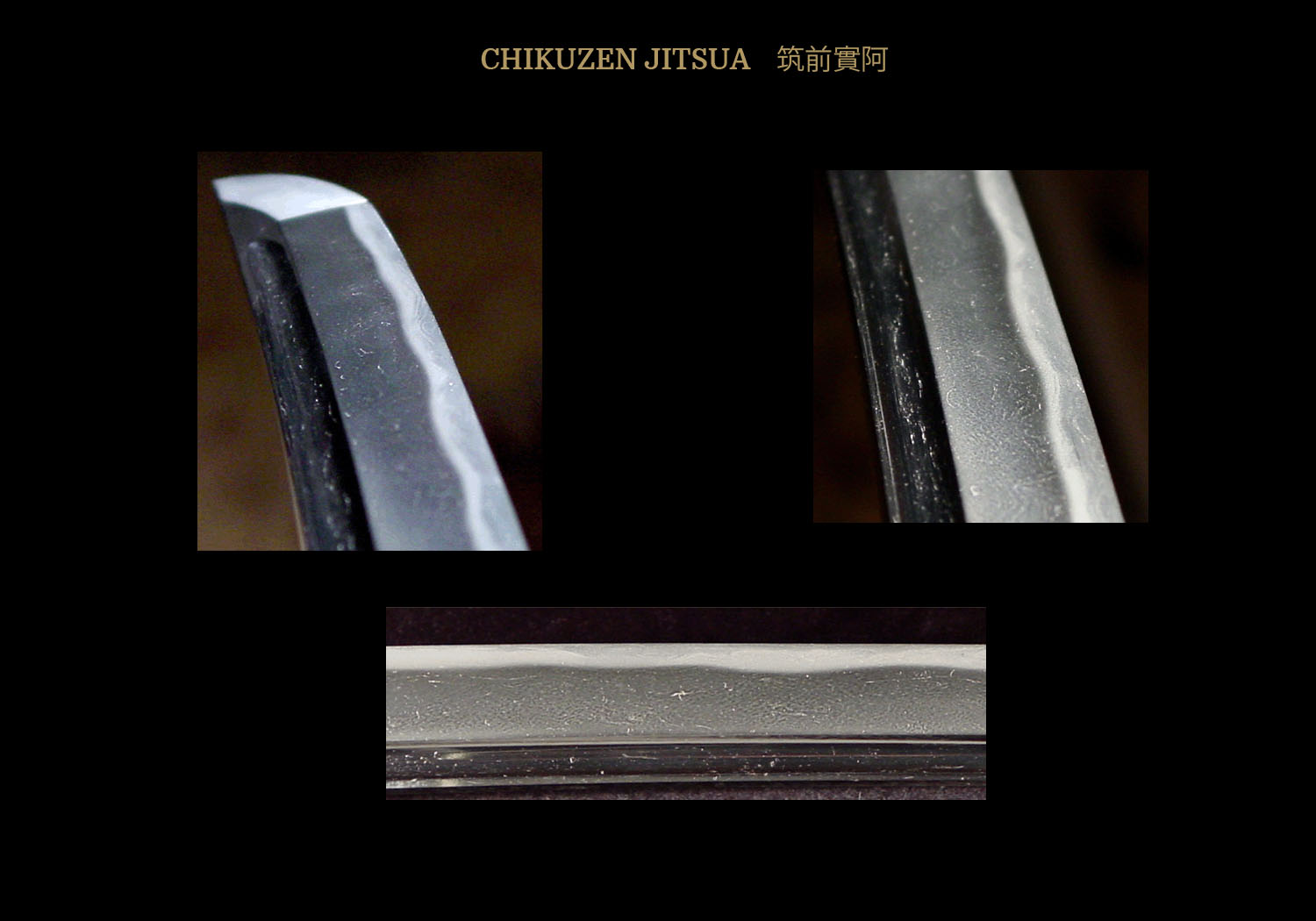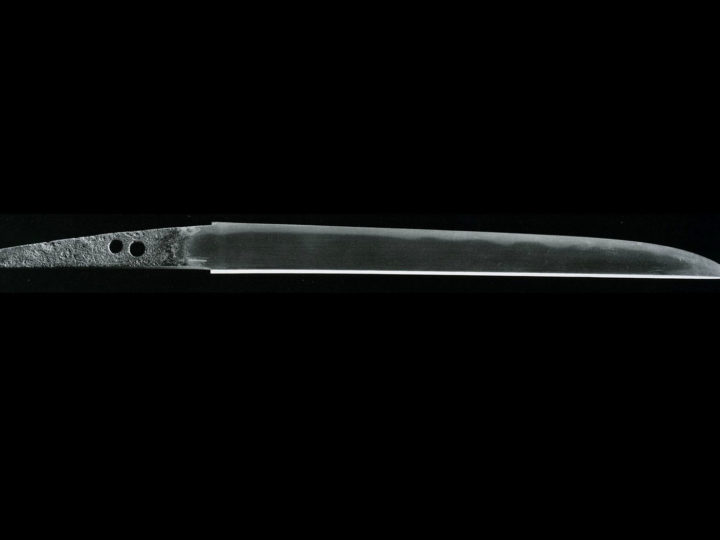
Chikuzen Jitsua (筑前實阿) is descended from the lineage of Ryôsai (良西), Nyûsai (入西) and Sairen Kuniyoshi (西蓮国吉), and he strictly adhered to the classic Kyushu style of workmanship, giving his works a powerful feeling. This school of sword making had its foundations in the Yamashiro Den. From these names we may speculate that these smiths were also priests of Buddhism. Of the works left by this impressive lineage of smiths, the works of Jitsua (實阿) are, by far, considered to have been the best. Within this school, he is surpassed only by his son, Ô-Sa (大左) who was a student of first his father Jitsua (實阿), and then of Soshu Masamune (正宗).
After the battle of Dan-no-Ura in 1185, many of the defeated Taira warriors sought refuge in Kyushu bringing with them the culture of the more advanced central Japan. There is no doubt that they had great influence on the sword making at this point in Japanese history (from the Kamakura era through the Nanbokucho Era). The Chikuzen smiths such as Ryôsai (良西), Nyûsai (入西) and Sairen Kuniyoshi (西蓮国吉) and Jitsua (實阿), were very skilled, producing swords of great strength. During the Nanbokucho era, Ashikaga Takeuji brought his army into Kyushu where they fought with the loyal followers of the Emperor. This constant fighting from the Kamakura era through the Nanbokucho era had a great influence on sword making in this region and we find the blades produced in Kyushu during this time of warfare were big, strong and very utilitarian.
The dates of Jitsua’s (實阿)extant works include the third year of Genkô (1333) and the second year of Enbun (1357), and although his periods of activity are rather clear, there are relatively few examples of his signed works. Together with his son Ô-Sa (大左), his ji-ha is bright and vivid, and his style of workmanship tends towards the Sôshû-den. Jitsua’s (實阿)style of workmanship includes a large itame hada that is prominent mixed with flowing masame, and, at times, there is a hint of ayasugi mixed into the jigane. The hamon have a nioiguchi that is somewhat cloudy with a suguha tempering.
Jitsua (實阿)adhered to the style of his mon, for the most part. His ubu works are of the koshizori shape (deep curve near the base). Ayasugi hada is seen in his works more often than in the works of his father. His hamon are spectacular and his ability to produce small and bright ko-nie is outstanding. This type of nie is so fine and delicate that it appears to be a white cloud floating on the blade. The hamon exhibits excellent activity such as kinsuji, sunagashi, and inazuma. Jitsua’s (實阿)hada is strong and is typical of swords made in Kyushu in this period. It is itame mixed with ayasugi and areas of a flowing masame hada. There will be a somewhat rough appearance to his hada in areas (o-hada). There is ji-nie in the hada together with chikei. Shirake utsuri will also be found.
The following are the general characteristics of the Chikuzen Jitsua Ha.
SUGATA: His works have a wide body and an extended bôshi. The shape gives a Soshu like feeling to the blade. The sugata will be typical of a blade from the Nanbokucho era. The kissaki will be chu-kissaki and sometimes it will be slightly extended.
JITETSU: Jitsua’s (實阿)hada is strong and is typical of swords made in Kyushu. It is itame mixed with ayasugi and areas of a flowing masame hada. There will be areas of o-hada.
HAMON: His works are done in nie deki and consist of a suguha based hamon. His hamon are spectacular and his ability to produce small and bright ko-nie is outstanding. This type of nie is so fine and delicate that it appears to be a white cloud floating on the blade. The interior of his ha is highly active while having an extremely tasteful appearance. The hamon exhibits excellent activity such as kinsuji, sunagashi, and inazuma.
BÔSHI: The bôshi is sugu or a shallow notare in feeling. Generally it is ko-maru turnback with hakikake.
HORIMONO: Bôhi and futatsu-hi are frequently found.
MEI: There are very few signed examples remaining. Two of them are Juyo Bijitsuhin and both are signed Jitsua Saku.
The blade shown below is a Jûyô Tôken katana with hon-zukuri construction and an iori-mune. It is o-suriage with the signature being lost due to the shortening.
The Jûyô Tôken papers for this sword are translated as follows:
Designated Jûyô Tôken at the 46th shinsa on the 5th of October 2000.
Katana: Unsigned and attributed to Jitsua [實阿].
Dimensions: Length: 71.0 centimeters; Curvature: 1.6 centimeters; Width at the Base: 3.05 centimeters; Width at the Point: 2.2; Kissaki Length: 4.5 centimeters; Nakago Length: 18.6; Nakago Curvature: none.
Construction: This is a shinogi-zukuri constructed blade with an iori-mune. The blade is wide, and there is note much conspicuous difference between the width at the base and the width at the point. In comparison to the width the shinogi is narrow. The blade is somewhat thick. The curvature is shallow, and there is a long chu-kissaki. The kitae is itame with ô-itame and a mixing in of mokume. There is powerfully flowing masame here and there. The entire jigane has prominent hada that is covered in ji-nie. There are areas where the ji-nie is powerful, and there is chikei activity. There is a blackish color to the jigane, which contains conspicuous shirake-utsuri. The hamon is narrow suguha in style with shallow notare and a mixing in of ko-notare and a hint of gunome. The habuchi is well covered in ko-nie and there is hotsure and uchinoke that is yubashiri in style. There are streaks of sunagashi and kinsuji activity. The nioiguchi has a subdued feeling with areas where it is cloudy. The bôshi on the omote is sugu and on the ura, it is shallow notare in feeling. There is a ko-maru point on both sides with brushing. There are bôhi carvings on both sides of the blade that taper off onto the nakago. The nakago is ô-suriage with a kiri end. The yasurime are katte-sagari, and there are two mekugi-ana. The blade is unsigned.
Explanation: Jitsua is the son of Sairen Kuniyosi [西蓮国吉], and is a sword-smith who is said to be the father of Ô-Sa. The dates on his extant works include the third year of Genkô (1333) and the second year of Enbun (1357), and although his periods of activity are rather clear, there are relatively few examples of his signed works. Together with his son Ô-Sa, his ji-ha is bright and vivid, and his style of workmanship tends towards the Sôshû-den. Jitsua’s style of workmanship includes a large itame hada that is prominent and flowing, and, at times, there is a hint of ayasugi mixed into the jigane. The hamon have a nioiguchi that is somewhat cloudy with a suguha tempering. He is connected to the lineage of Ryôsai [良西], Nyûsai [入西] and Sairen, and he strictly adhered to the classic Kyushu style of workmanship, giving his works a powerful feeling. In addition, in comparison to such smiths as Nyûsai and Seiren, with Jitsua, his blades are wide, and the jigane is large patterned with a prominent hada pattern that is flowing. Among the smiths in this school, he has the greatest tendency towards a coarse jigane.
As for this sword, it has a construction that is wide, and the chû-kissaki is long. The kitae is itame that has a prominent and flowing hada pattern, and there is the appearance of blackish colored steel. The jigane contains conspicuous shirake-utsuri. The hamon is narrow suguha in style that is well covered in ji-nie, and there is hotsure, uchinoke and yubashiri style activity. In addition, the style of workmanship includes a nioiguchi that has a cloudy feeling appearance. Among the classic Kyushu schools, Jitsua is the one who is the most prized, and his work clearly exhibits distinguishing characteristics. His blades are wide and somewhat thick, his chû-kissaki are longish, and he had a fondness for making magnificently shaped blades. The interior of his ha are highly active while having an extremely tasteful appearance. Even among works with similar attributions, this sword is a masterpiece.





